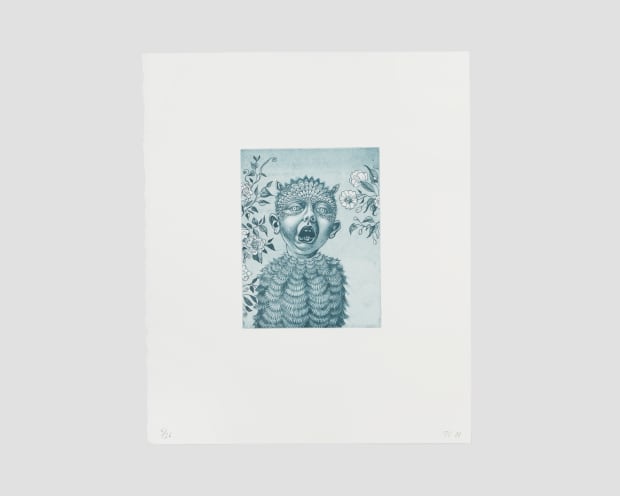
This is Zane Bennett's second digital exhibition in an ongoing series showcasing new and exciting print releases. Make sure to check out last month's exhibition, and read on for commentary from Small Gems curator Brad Hart and Black Rock Editions Director Christina Ziegler Campbell.
These small-scale etchings are true gems. Some of these artists were completely new to the intaglio process but all managed exceptional works through collaboration with the master printers at Landfall Press and Black Rock Editions. Each print uses multiple etching techniques to create the image, showcasing the unique marks the medium allows. The printers were able to choose methods best suited for each artist’s unique drawing style. Each of these prints are perfect examples of what this collaborative process can accomplish.

BRAD HART: Everything about A Little Linger is just exquisitely done. In an etching the artist is using a needle to scratch through an acid-proof resist and make lines, and for an aquaint they're also using a powdered rosin to create a tonal effect. The super soft tonal range going across the background, that's a very difficult thing to get to work in etching.
CHRISTINA ZIEGLER CAMPBELL: This was Katherine's first etching, which is crazy because of the number of techniques. A lot of times we'll start someone out with one easier technique like hard ground etching. But with A Little Linger we really threw her in: soft ground, hard ground, creep-bite.
BH: With creep-bite, you're gradually lowering the plate into the acid, and the longer it's in the acid the darker the tones will be. If you do it wrong, you get hard lines instead of that gradual shift you see on the wall in the background of this print.
CZC: And the asphaltum resist, which prevents the acid from reacting to the copper plate, is applied with an airbrush, which preserves the delicacy of that aquatint gradient. A really good aquatint looks like a matte velvet, which they accomplished here.
BH: There was also a lot of scraping and burnishing done to the plate, which is visible on the skin of the figure. In an etching you're creating texture on the plate, and that's what holds the ink, so if you smooth that texture back out you can create highlights like that.

BH: In Anachronism, Carol is using a lot of the same techniques that Katherine used in A Little Linger. But she's added chine collé which creates some really nice, soft tones.
CZC: There's reversed text coming down in the background of this print. The chine collé helps make the text into an abstract texture.
BH: Chine collé is a thin, usually colored paper. You ink the plate, apply glue to the back of the chine collé paper, lay it facedown on the plate, put the printing paper down, and run it through the press. The colored sheet adheres to the support sheet and the etching prints on top of both of them. In this case, the piece of chine collé covers the entire plate, but in the case of James Havard's Untitled OK (also in this exhibition), the paper is adhered in smaller pieces across the plate.
CZC: This is a printer's proof, so you can see Carol's handwritten tribute to the master printer just below the printed image. Her writing cascades down, echoing the text in the background of the piece.

BH: Aquatint is the most direct way of getting tone onto the plate. The ideal is to get a 50% covering of fine rosin dust on the plate.
CZC: Rosin is a powdered tree sap. It has a really low melting point, which is why you could fuse rosin to a copper plate by using a low flame like a torch or a hot plate.
BH: The best way to distribute the rosin is to place the plate in an aquatint box, where the dust is stirred up and then lands evenly on the plate. Then you heat up the plate, which melts the little rosin dots onto the plate. Then you look at it with a magnifying glass to make sure it's distributed evenly. When you etch the plate, you stop out the parts that you want to be the lightest first—the highlights on the face, the flowers, the lightest parts of the background—and then repeat the process for each tone, stopping out the darkest parts last.
435 S. Guadalupe St. fl. 2
Santa Fe, NM 87501
info@zanebennettgallery.com
505.982.8111
This website uses cookies
This site uses cookies to help make it more useful to you. Please contact us to find out more about our Cookie Policy.